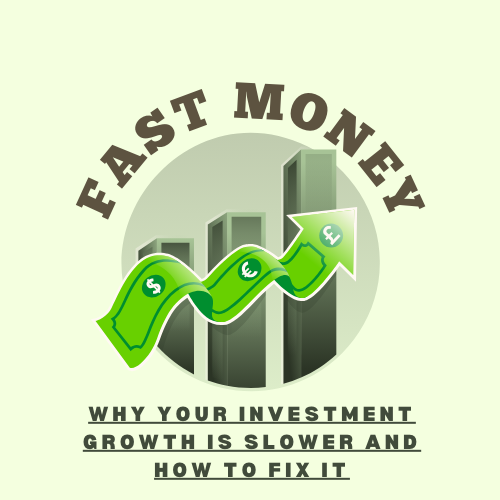The secret to accumulating money is investment growth, yet many investors discover that their portfolios are expanding more slowly than they had anticipated. Returns can be hampered by a number of things, including exorbitant fees, poor asset allocation, and market swings. Performance can be considerably enhanced by comprehending these obstacles and implementing tactical changes. You may increase your profits by diversifying your investments, cutting back on wasteful spending, and optimizing your portfolio. This manual examines the causes of sluggish investment growth as well as possible fixes.
Common Reasons Behind Slow Investment Growth
Poor Asset Allocation Slows Investment Growth
A lot of investors distribute their money without a clear plan. Your potential gains may be restricted if you fail to diversify or are overly exposed to low-return investments. Returns can be increased by having a well-balanced portfolio of stocks, bonds, and alternative investments. It’s crucial to periodically rebalance your portfolio to match your financial objectives and risk tolerance.
High Fees and Hidden Costs Erode Your Returns
Over time, excessive fees from advisory services, mutual funds, or transaction costs may reduce your returns. Investors often underestimate the influence of fees on investment growth. Returns can be increased by moving to exchange-traded funds (ETFs) or inexpensive index funds. Always check the transaction fees and expenditure ratios related to your investments.
Lack of Diversification Increases Risk
Overinvesting in one stock, industry, or asset class might put you at needless danger. Spreading your investments over several sectors, asset classes, and geographical areas is made easier with diversification. Long-term returns can be increased and volatility can be decreased with a well-diversified portfolio.
Market Timing Mistakes Hurt Investment Growth
Attempting to time the market frequently results in bad choices and lost chances. During downturns, many investors panic and either sell at a loss or put off reinvesting for too long. Dollar-cost averaging is one long-term, reliable investment strategy that can help reduce risks and guarantee stable gain over time.
Low Savings Rate and Inconsistent Contributions
The amount and frequency of your investments have a significant impact on their growth. Your wealth accumulation may be slowed by irregular contributions or a poor savings rate. Automating contributions and increasing your savings rate over time can significantly boost portfolio growth.
How to Fix Slow Investment Growth
Optimize Asset Allocation and Portfolio Strategy
Investment returns can be increased with a well-structured portfolio that fits your objectives and risk tolerance. Think about lowering your reliance on low-yield investments and expanding your exposure to growth assets like stocks. Maintaining ideal growth requires routinely reviewing and modifying your asset allocation.
Reduce Investment Fees and Costs
Exorbitant investment fees diminish total profits over time. To cut costs, choose commission-free platforms, robo-advisors, or inexpensive funds. Steer clear of pointless transactions that result in extra charges and taxes.
Focus on Long-Term Investment Strategies
Take a long-term approach instead of aiming for quick profits. Investing in dividend equities, index funds, and exchange-traded funds (ETFs) can yield consistent, compound gains. Maintaining your investment throughout market turbulence guarantees that you will reap the rewards of long-term growth.
Increase Contributions and Stay Consistent
Over time, even modest increases in contributions can have a big impact. Investment automation eliminates emotional decision-making and guarantees consistency. To optimize savings, make use of tax-advantaged accounts such as 401(k)s and IRAs.
Diversify Across Asset Classes and Markets
Investing in a variety of asset types and international markets can increase risk-adjusted returns. To increase diversification, think about making investments in foreign equities, commodities, and real estate. Don’t invest all of your money in one kind of investment.
Frequently Asked Questions (FAQs)
Q1: How long does it take for investments to show significant growth?
Market performance, contribution rate, and asset allocation are some of the variables that affect investment growth. Long-term investments usually pay off handsomely over a ten- to twenty-year period.
Q2: Can I speed up my investment growth without taking on too much risk?
Indeed. Consistent contributions, low-cost investments, and diversification all aid in risk management and growth acceleration.
Q3: How do investment fees affect long-term returns?
Over time, compound returns are greatly diminished by high costs. Reducing fees guarantees that more of your money remains invested and value increases.
Q4: Is market timing a good strategy for boosting investment growth?
No. Timing the market is dangerous and frequently results in bad investment choices. A consistent, long-term strategy works well.
Q5: Should I invest in individual stocks or index funds for better growth?
Index funds are a better option for long-term growth since they offer diversity and lower risk than individual stocks.
Conclusion
Investment growth necessitates long-term thinking, consistency, and strategic planning. You can increase your returns by diversifying your portfolio, cutting costs, increasing contributions, and optimizing asset allocation. To keep your finances on course, steer clear of typical blunders like market timing and exorbitant fees. Over time, minor adjustments can result in substantial financial development. Take charge of your financial future now and use more intelligent tactics to boost the growth of your investments.
